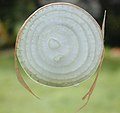Monocotyledon
Monocotyledon or monocot is a type of flowering plant. The term "monocotyledon" is derived from the single (mono) seed leaf (cotyledon) present in the seeds of these plants. Monocots are one of the two major groups of flowering plants, or angiosperms, the other being the dicotyledons.
Characteristics[edit]
Monocots have several distinguishing characteristics. They typically have one cotyledon, or seed leaf, in their seeds. The leaf veins in most monocots are usually parallel. The flower parts of monocots usually come in multiples of three. The primary root, or radicle, of monocots usually dies off and is replaced by adventitious roots.
Classification[edit]
Monocots are classified under the class Liliopsida in the Angiosperm Phylogeny Group system. They are further divided into several orders, including the Asparagales, Liliales, and Poales, among others.
Diversity[edit]
There are about 60,000 species of monocots, making up around 25% of all flowering plants. They are found in a wide range of habitats, from deserts to aquatic environments. Some well-known monocots include grasses, lilies, orchids, and palms.
Economic Importance[edit]
Many monocots are of great economic importance. For example, rice, wheat, and corn are monocots and are some of the most important food crops in the world. Other economically important monocots include sugar cane, banana, onion, garlic, and bamboo.
Evolution[edit]
The monocots are believed to have evolved around 140-200 million years ago. They are thought to have evolved from the dicotyledons, with the main difference being the number of cotyledons in the seed.
See Also[edit]
Ad. Transform your life with W8MD's Budget GLP-1 injections from $75


W8MD offers a medical weight loss program to lose weight in Philadelphia. Our physician-supervised medical weight loss provides:
- Weight loss injections in NYC (generic and brand names):
- Zepbound / Mounjaro, Wegovy / Ozempic, Saxenda
- Most insurances accepted or discounted self-pay rates. We will obtain insurance prior authorizations if needed.
- Generic GLP1 weight loss injections from $75 for the starting dose.
- Also offer prescription weight loss medications including Phentermine, Qsymia, Diethylpropion, Contrave etc.
NYC weight loss doctor appointmentsNYC weight loss doctor appointments
Start your NYC weight loss journey today at our NYC medical weight loss and Philadelphia medical weight loss clinics.
- Call 718-946-5500 to lose weight in NYC or for medical weight loss in Philadelphia 215-676-2334.
- Tags:NYC medical weight loss, Philadelphia lose weight Zepbound NYC, Budget GLP1 weight loss injections, Wegovy Philadelphia, Wegovy NYC, Philadelphia medical weight loss, Brookly weight loss and Wegovy NYC
|
WikiMD's Wellness Encyclopedia |
| Let Food Be Thy Medicine Medicine Thy Food - Hippocrates |
Medical Disclaimer: WikiMD is not a substitute for professional medical advice. The information on WikiMD is provided as an information resource only, may be incorrect, outdated or misleading, and is not to be used or relied on for any diagnostic or treatment purposes. Please consult your health care provider before making any healthcare decisions or for guidance about a specific medical condition. WikiMD expressly disclaims responsibility, and shall have no liability, for any damages, loss, injury, or liability whatsoever suffered as a result of your reliance on the information contained in this site. By visiting this site you agree to the foregoing terms and conditions, which may from time to time be changed or supplemented by WikiMD. If you do not agree to the foregoing terms and conditions, you should not enter or use this site. See full disclaimer.
Credits:Most images are courtesy of Wikimedia commons, and templates, categories Wikipedia, licensed under CC BY SA or similar.
Translate this page: - East Asian
中文,
日本,
한국어,
South Asian
हिन्दी,
தமிழ்,
తెలుగు,
Urdu,
ಕನ್ನಡ,
Southeast Asian
Indonesian,
Vietnamese,
Thai,
မြန်မာဘာသာ,
বাংলা
European
español,
Deutsch,
français,
Greek,
português do Brasil,
polski,
română,
русский,
Nederlands,
norsk,
svenska,
suomi,
Italian
Middle Eastern & African
عربى,
Turkish,
Persian,
Hebrew,
Afrikaans,
isiZulu,
Kiswahili,
Other
Bulgarian,
Hungarian,
Czech,
Swedish,
മലയാളം,
मराठी,
ਪੰਜਾਬੀ,
ગુજરાતી,
Portuguese,
Ukrainian









